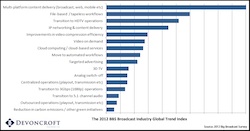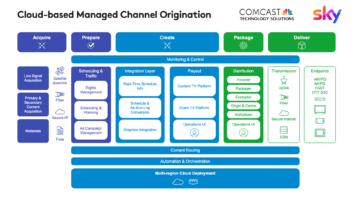
Cloud computing is one of the hot topics at IBC, but Devoncroft Partners’ research shows that it’s still early days for deployments in broadcasting.
Last year at IBC2011 we met with a large number of industry executives to discuss what broadcast industry trends to add, if any, to Devoncroft’s annual global study of the broadcast industry, the Big Broadcast Survey (BBS).
During our meetings with more than 50 industry executives, one trend was mentioned virtually every time – ‘cloud computing/cloud-based services.’ However, when we asked what specific information about cloud technology these people wanted to know, there was a wide divergence of opinion. Some were interested in how broadcasters plan to use cloud technology, and what parts of the workflow broadcasters might migrate to the cloud first.
Others wanted to know if broadcasters would simply transfer existing workflows to the cloud, or whether cloud technology will enable entirely new workflows. And finally there were some who confessed that they didn’t actually know what they wanted to know; they just wanted to understand more about cloud technology and its implications for the broadcast industry. Ultimately, we added questions about cloud technology to the 2012 BBS in an attempt to answer some of these questions.
As seen in Figure 1, the nearly 10,000 respondents to the 2012 BBS who we asked to prioritise the commercial importance to their businesses of a variety of broadcast industry trends, ranked ‘cloud computing / cloud-based services’ #7 out of 16 in our 2012 BBS Broadcast Industry Global Trends Index.
Although cloud technology ranks in the top half of our 2012 Trends Index, it is significantly below other topics such as multi-platform content delivery and other traditional drivers of spending such as the transition to HDTV, and the move to file-based workflows.
Figure 1: Commercial Drivers and Obstacles for Cloud Technology in Broadcast (see above)
To better understand the commercial drivers behind the answers of these respondents, we asked those respondents who said that ‘cloud computing / cloud-based services’ was the most important trend to their commercial success in the future why they feel this is the case. The results are shown in the table below.
Figure 2: Commercial Drivers for Deployment of Cloud Technology in Broadcast Industry
The top commercial drivers cited by broadcast customers for deploying cloud technology in the broadcast industry highlight the fact ‘cloud technology/cloud services’ are principally viewed today as a way to enable new workflows and increase efficiencies. While potential cost savings — achieved through increased efficiencies, shifting costs to OpEx, and SaaS services — are arguably the most straightforward rationale for deploying cloud technology, these results imply that customers also see the cloud as a potential driver of revenue, particularly if it enables new workflows, drives collaboration, and increases the overall utilisation of content.
While the benefits of deploying cloud technology are relatively clear, it is also useful to understand the obstacles that customers feel may prevent them from deploying this technology today. Even those BBS respondents who regard cloud technology as the most important commercial driver for their business note a wide range of obstacles preventing them from deploying it today.
The most commonly cited factors are budget/cost, availability of bandwidth, content security, and the perception that cloud technology is too immature for broadcast applications. Other factors cited as obstacles include lack of skilled personnel, rights issues, internal bureaucracy, and disruption to existing workflows.
Despite these obstacles, customers are seriously investigating this technology, and technology vendors are investing in the development of a wide variety of cloud technologies and services.
Given the hype surrounding cloud technology, and the level of investment from vendors, it is perhaps not surprising to find that technology suppliers see cloud technology as more important to their commercial success than do their customers.
Indeed, it turns out that those respondents who are most interested in, and have the most to gain commercially in 2012 from ‘cloud technology/cloud services’ are the parties whose business is developing and selling cloud technology.
Figure 3: Commercial Importance of Cloud Technology by Respondent Type
This does not mean that the concept of cloud in broadcast is not important. Our research confirms that there is considerable interest in deploying cloud technology and cloud services in the broadcast industry.
However, it appears that significant issues, including immature technology, cost, security, bandwidth, and viable business models, must be overcome before cloud technology can deliver commercial success that lives up to the hype it has generated over the past year.
Joe Zaller is the founder and president of Devoncroft Partners, which provides market research and strategic consulting services to a wide range of digital media clients. He can be contacted at [email protected].







